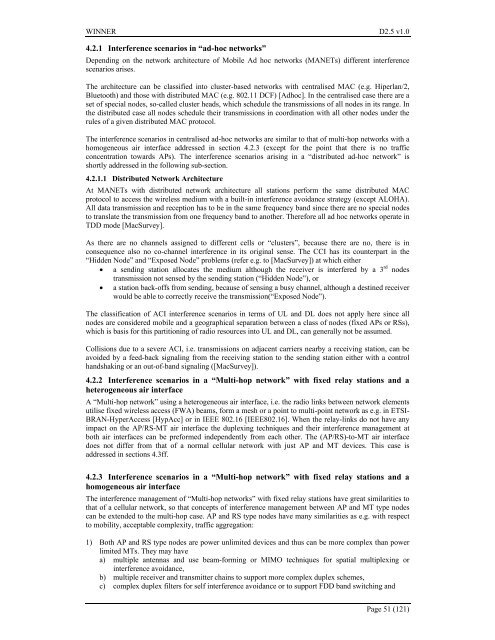IST-2003-507581 WINNER D2.5 v1.0 Duplex ... - Celtic-Plus
IST-2003-507581 WINNER D2.5 v1.0 Duplex ... - Celtic-Plus
IST-2003-507581 WINNER D2.5 v1.0 Duplex ... - Celtic-Plus
- No tags were found...
Create successful ePaper yourself
Turn your PDF publications into a flip-book with our unique Google optimized e-Paper software.
<strong>WINNER</strong> <strong>D2.5</strong> <strong>v1.0</strong>4.2.1 Interference scenarios in “ad-hoc networks”Depending on the network architecture of Mobile Ad hoc networks (MANETs) different interferencescenarios arises.The architecture can be classified into cluster-based networks with centralised MAC (e.g. Hiperlan/2,Bluetooth) and those with distributed MAC (e.g. 802.11 DCF) [Adhoc]. In the centralised case there are aset of special nodes, so-called cluster heads, which schedule the transmissions of all nodes in its range. Inthe distributed case all nodes schedule their transmissions in coordination with all other nodes under therules of a given distributed MAC protocol.The interference scenarios in centralised ad-hoc networks are similar to that of multi-hop networks with ahomogeneous air interface addressed in section 4.2.3 (except for the point that there is no trafficconcentration towards APs). The interference scenarios arising in a “distributed ad-hoc network” isshortly addressed in the following sub-section.4.2.1.1 Distributed Network ArchitectureAt MANETs with distributed network architecture all stations perform the same distributed MACprotocol to access the wireless medium with a built-in interference avoidance strategy (except ALOHA).All data transmission and reception has to be in the same frequency band since there are no special nodesto translate the transmission from one frequency band to another. Therefore all ad hoc networks operate inTDD mode [MacSurvey].As there are no channels assigned to different cells or “clusters”, because there are no, there is inconsequence also no co-channel interference in its original sense. The CCI has its counterpart in the“Hidden Node” and “Exposed Node” problems (refer e.g. to [MacSurvey]) at which either• a sending station allocates the medium although the receiver is interfered by a 3 rd nodestransmission not sensed by the sending station (“Hidden Node”), or• a station back-offs from sending, because of sensing a busy channel, although a destined receiverwould be able to correctly receive the transmission(“Exposed Node”).The classification of ACI interference scenarios in terms of UL and DL does not apply here since allnodes are considered mobile and a geographical separation between a class of nodes (fixed APs or RSs),which is basis for this partitioning of radio resources into UL and DL, can generally not be assumed.Collisions due to a severe ACI, i.e. transmissions on adjacent carriers nearby a receiving station, can beavoided by a feed-back signaling from the receiving station to the sending station either with a controlhandshaking or an out-of-band signaling ([MacSurvey]).4.2.2 Interference scenarios in a “Multi-hop network” with fixed relay stations and aheterogeneous air interfaceA “Multi-hop network” using a heterogeneous air interface, i.e. the radio links between network elementsutilise fixed wireless access (FWA) beams, form a mesh or a point to multi-point network as e.g. in ETSI-BRAN-HyperAccess [HypAcc] or in IEEE 802.16 [IEEE802.16]. When the relay-links do not have anyimpact on the AP/RS-MT air interface the duplexing techniques and their interference management atboth air interfaces can be preformed independently from each other. The (AP/RS)-to-MT air interfacedoes not differ from that of a normal cellular network with just AP and MT devices. This case isaddressed in sections 4.3ff.4.2.3 Interference scenarios in a “Multi-hop network” with fixed relay stations and ahomogeneous air interfaceThe interference management of “Multi-hop networks” with fixed relay stations have great similarities tothat of a cellular network, so that concepts of interference management between AP and MT type nodescan be extended to the multi-hop case. AP and RS type nodes have many similarities as e.g. with respectto mobility, acceptable complexity, traffic aggregation:1) Both AP and RS type nodes are power unlimited devices and thus can be more complex than powerlimited MTs. They may havea) multiple antennas and use beam-forming or MIMO techniques for spatial multiplexing orinterference avoidance,b) multiple receiver and transmitter chains to support more complex duplex schemes,c) complex duplex filters for self interference avoidance or to support FDD band switching andPage 51 (121)
















